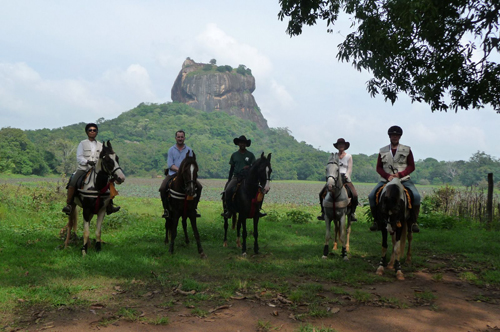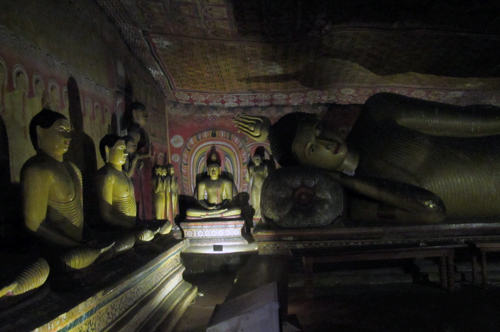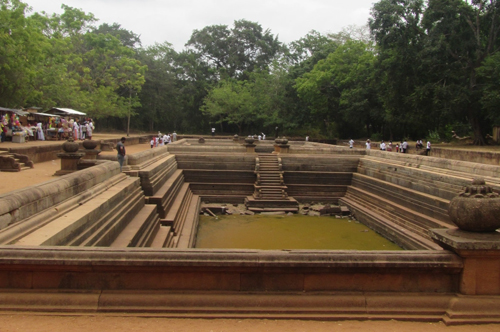
|
Overview Asia
Horseback riding tours
India
Mongolia
Sri Lanka
|

|
|

|
|
|
|
Horseback riding vacations in
Sri Lanka
In the past, Sri Lanka was renowned for its cavalry but since the 1950-60s, mainly for political reasons, horseback riding almost entirely disappeared from the country. However, during the past 20 years, things have begun to change and horseback riding activities are starting to become more popular.
Horses in Sri Lanka
Before it was colonized, Sri Lanka maintained cavalry regiments for centuries. However, due to the tropical climate, breeding horses was difficult so trade of horses with Pakistan, India and Arabian nations was very common.
During colonial times (16th century), the Dutch, Portuguese and British imported their own horses and created many stables, as horses were essential for their armies. They also imported the sport of horseracing and several racecourses were created all over the country.
Just after its independence, in 1948, horse riding and racing in particular was very popular. However, as political conflicts began to arise, the sport began to be seen as an elite and colonial sport and horse-riding activities almost completely disappeared from the country.
Thankfully, in recent year, it seems like horseback riding is making a comeback. The country’s army even got a new cavalry back in 2013 thanks to a gift from Pakistan.
We now offer beautiful riding holidays across the most beautiful parts of the country.
Central Sri Lanka is full of history, with the colonial city of Kandy, the Sigiriya rock fortress and the sacred city of Mahiyanganaya. You can discover all these sights during our Coastal & Historic Ride.
The Western coast is home to sandy beaches and coconut plantations. Join our Sea & Jungle Tour, to learn more about the life of local fishermen.
Finally, you can discover the best of Sri Lanka and tour the entire island.
Sri Lanka Geography and Climate
The island nation of Sri Lanka is found in the Indian Ocean, just South of India. Its climate is strongly influenced by the monsoon winds, bringing luxuriant vegetation to the southern half of the country, while the northern half is mainly dry.
The country mostly stands at low elevation with some rolling hills and small mountains in the south central part of the island.
|
|
Holidays on horseback in Sri Lanka
See Mini Country Guide
|
Below is a list of our trips in this area with video clips.
 Click on the 'watch video' icon

to view a video clip,
Sri Lanka
Travel restrictions
In December 2022, the Government of Sri Lanka announced that travelers are no longer required to produce COVID-19 vaccination certificates on arrival in Sri Lanka. Pre-departure COVID-19 tests are also no longer required before arrival.
On June 17th 2022, the Government of Sri Lanka announced that COVID-19 travel insurance is no longer mandatory for all visitors. However, it is important to ensure you take out comprehensive travel insurance before you travel abroad.
Measures taken by government
The wearing of a face mask in public areas is no longer mandatory.
Testing
PCR and/or antigen tests are available and test results are reliably available within 24 hours.
COVID-19 tests can be done at any private hospital. The average cost per test is around 7,000 Sri Lankan Rupees (approximately $20). Test results are forwarded via email.
Emergency number (related to COVID-19) while visiting the country
Information not available
Source:
UK Government - Sri Lanka Entry Requirements https://www.gov.uk/foreign-travel-advice/sri-lanka/coronavirus
Checked on April 5th 2023
US Embassy in Sri Lanka https://lk.usembassy.gov/covid-19-information/
Published on March 27th 2023 (checked on April 5th 2023)
For more information please visit our COVID-19 Updates page at https://www.hiddentrails.com/article/covid19update.aspx
|
|
Sri Lanka
At A glance
Capital City: Colombo (commercial capital); Sri Jayewardenepura Kotte (legislative capital)
Land size: 64,630 sq km
Population: 23,187,516 (2022 est.)
Official languages: Sinhala and Tamil
Currency: Sri Lankan Rupee (Rs / LKR)
UNESCO properties and sites:
- Ancient City of Polonnaruwa
- Ancient City of Sigiriya
- Old Town of Galle and its Fortifications
- Rangiri Dambulla Cave Temple
- Sacred City of Anuradhapura
- Sacred City of Kandy
- Central Highlands of Sri Lanka
- Sinharaja Forest Reserve
Source: https://www.cia.gov/the-world-factbook/countries/sri-lanka/
Sri Lanka will enchant you with its pristine beaches, lush landscapes, and rich cultural heritage. Explore the vibrant capital city of Colombo, where bustling markets, colonial architecture, and flavorful cuisine create a captivating atmosphere. Discover the ancient ruins of Sigiriya, climbing to the top of the iconic rock fortress for breathtaking views of the surrounding countryside. Experience the wildlife wonders of Yala National Park, as you embark on a thrilling safari to spot elephants, leopards, and a myriad of bird species.
The country features varied terrains and vast expanses making it an ideal destination for horse riding holidays. Ride along the palm-fringed beaches of Kalpitiya, feeling the warm sand beneath your horse's hooves as you explore the pristine coastline. Discover the lush tea plantations of Nuwara Eliya, trotting through rolling hills, emerald-green tea fields, and misty valleys.
Brief History
The first Sinhalese arrived in Sri Lanka late in the 6th century B.C., probably from northern India. Buddhism was introduced circa 250 B.C., and the first kingdoms developed at the cities of Anuradhapura (from circa 200 B.C. to circa A.D. 1000) and Polonnaruwa (from about 1070 to 1200). In the 14th century, a south Indian dynasty established a Tamil kingdom in northern Sri Lanka.
The Portuguese controlled the coastal areas of the island in the 16th century followed by the Dutch in the 17th century. The island was ceded to the British in 1796, became a crown colony in 1802, and was formally united under British rule by 1815. As Ceylon, it became independent in 1948; its name was changed to Sri Lanka in 1972.
Prevailing tensions between the Sinhalese majority and Tamil separatists erupted into war in July 1983. Fighting between the government and Liberation Tigers of Tamil Eelam (LTTE) continued for over a quarter century. The government defeated the LTTE in May 2009.
During the post-conflict years under President Mahinda RAJAPAKSA, the government initiated infrastructure development projects, many of which were financed by loans from China. His regime faced significant allegations of human rights violations and a shrinking democratic space for civil society. In 2015, a new coalition government headed by President Maithripala SIRISENA of the Sri Lanka Freedom Party and Prime Minister Ranil WICKREMESINGHE of the United National Party came to power with pledges to advance economic, governance, anti-corruption, reconciliation, justice, and accountability reforms. However, implementation of these reforms has been uneven. In October 2018, President SIRISENA attempted to oust Prime Minister WICKREMESINGHE, swearing in former President RAJAPAKSA as the new prime minister and issuing an order to dissolve the Parliament and hold elections. This sparked a seven-week constitutional crisis that ended when the Supreme Court ruled SIRISENA’s actions unconstitutional, RAJAPAKSA resigned, and WICKREMESINGHE was reinstated.
In November 2019, Gotabaya RAJAPAKSA won the presidential election and appointed his brother, Mahinda, prime minister. A combination of factors including the impact of the worldwide COVID pandemic; severe shortages of food, medicine, and fuel; and power outages have triggered increasingly violent protests in Columbo. Longtime parliamentarian and former five-time prime minister, Ranil WICKREMESINGHE replaced Mahinda RAJAPASKA as prime-minister in mid-May 2022, with a mandate to resolve the country's economic problems.
Source: https://www.cia.gov/the-world-factbook/countries/sri-lanka/
Cultural Insights
Many of the most important rules of etiquette serve to mark differences in social rank. Both Sinhala and Tamil contain a range of linguistic markers for status as well as relative social distance and intimacy. In routine social interactions, personal names are avoided in preference to nicknames, relationship terms, or other titles.
Gender is also an important factor in determining appropriate conduct. Among all but the most urbanized, women are expected to defer to men of relatively equal status and to avoid all implication of sexual impropriety by keeping themselves well covered at all times. They are also expected to refuse all alcohol and tobacco and to refrain from direct physical contact with men. Between members of the same gender and with children, however, there is a great deal of physical contact that emphasizes closeness.
At meals, women usually eat last, after they have served the men and the children of the household, although visitors are served first, regardless of gender. While the more Westernized may use silverware, food is commonly eaten with the right hand, a preference that extends to other domains as well.
In public, people tend to speak in hushed tones if at all, although leaders and sellers are expected to shout.
Large emotional displays of any type are uncommon in public.
Greetings are often unvocalized, with broad smiles exchanged between strangers and a friendly raised eyebrow to frequent acquaintances.
When new people are involved in a conversation, the mutual acquaintance is asked questions about the stranger. Seldom does direct self-introduction occur.
Unusual behavior of any kind draws unconcealed observation.
Source: https://www.everyculture.com/Sa-Th/Sri-Lanka.html
Transportation
By Air
Bandaranaike International Airport (CMB), also known as Katunayake Airport, is the main port of entry for international travelers to Sri Lanka. It deserved the city of Colombo and offers direct connections to many International airports from neighboring countries such as Sydney, Delhi and Dubai.
Source: https://getbybus.com/en/blog/airports-in-greece/
Money
Most major banks will allow Visa and Mastercard cash withdrawals.
There are ATMs in major towns and cities but not all of them accept international cards.
Source: https://www.gov.uk/foreign-travel-advice/sri-lanka
Health
The Sri Lankan healthcare system is under strain due to the impact of the pandemic and the economic crisis which has led to shortages of certain medicines. Access to routine and emergency healthcare may be limited.
If you need emergency medical assistance during your trip, dial 011 2691111 and ask for an ambulance or dial 1990. You should contact your insurance/medical assistance company promptly if you are referred to a medical facility for treatment.
Emergency medical treatment isn’t easily available outside main cities, and you may have to be brought to Colombo for treatment.
Treatment in private hospitals can be expensive and the options for repatriation to the UK or neighboring countries in an emergency are limited and very expensive. Make sure you have adequate travel health insurance and accessible funds to cover the cost of any medical treatment abroad and repatriation.
The availability of medical supplies is uneven; therefore, travelers should carry any special medications with them.
Source: https://www.gov.uk/foreign-travel-advice/sri-lanka
https://travel.state.gov/content/travel/en/international-travel/International-Travel-Country-Information-Pages/SriLanka.html
Electricity
Sri Lanka operates on a 230V supply voltage and uses type D, G and M plugs.
The Type D electrical plug has three large round pins in a triangular pattern. Type M plugs are often used alongside Type D plugs for larger appliances and as a result, some sockets work with both Type D and Type M plugs.
The Type G electrical plug has three rectangular blades in a triangular pattern and has an incorporated fuse (usually a 3 amps fuse for smaller appliances such as a computer and a 13 amps one for heavy duty appliances such as heaters). British sockets have shutters on the live and neutral contacts so that foreign objects can’t be introduced into them.
The Type M plug has three round pins in a triangular pattern and looks similar to the Indian Type D plug, but its pins are much larger. Type M plugs are sometimes used for bigger appliances in countries that make use of Type D plugs, as well as in Israel (Type H). Therefore, sockets in these countries sometimes work with Type M plugs.
Source: https://www.iec.ch/world-plugs
Communication
Time zone in Sri Lanka: India Standard Time (GMT+5:30)
International country code – 94
Sri Lanka’s fixed-line telephony market was one of the very few in the world to experience a significant upsurge in subscriptions in 2020. While the country suffers from a relatively poor fixed-line infrastructure and a correspondingly strong mobile sector, demand for traditional phone services increased 14% in 2020.
Sri Lanka possesses a relatively low number of computers per household so the fixed broadband market’s success comes off a small base.
The market will be boosted, come 2022, by the anticipated launch of commercial 5G mobile services.
Source: https://www.cia.gov/the-world-factbook/countries/sri-lanka/
Phrasebook
| English |
Sinhala |
| Hello! |
Halō |
| Goodbye |
Āyubōvan |
| Good morning |
Subha udaēsanak |
| Good evening |
Subha sandyāvak |
| Good night |
Subha rātriyak |
| Please |
Karunākaralā |
| Thank you |
Stūtiyi |
| Yes |
Ov |
| No |
Naeta |
| English |
Tamil |
| Hello! |
Vaṇakkam |
| Goodbye |
Piriyāviṭai |
| Good morning |
Kālai vaṇakkam |
| Good evening |
Maalai vanakkam |
| Good night |
Iṉiya iravu |
| Please |
Tayavuceytu |
| Thank you |
Naṉṟi |
| Yes |
Ām |
| No |
Illai |
Source: https://ling-app.com/ta/basic-tamil-phrases/
http://www.nemolanguageapps.com/phrasebooks/sinhala
Entry Requirements
All visitors are advised to apply online for an Electronic Travel Authorisation (ETA) to enter Sri Lanka. Visitors can apply for an ETA on the ETA website. Further information on eligibility is available on the Department of Immigration and Emigration website.
On arrival visa facilities are available, however applying for an ETA before travel is advised for ease of travel and to prevent delays on arrival.
Tourist visas are normally valid for 30 days. If you overstay your visa you could be fined or detained by the police.
If you are visiting Sri Lanka, your passport should be valid for 6 months from the date you arrive.
Source: https://www.gov.uk/foreign-travel-advice/sri-lanka/entry-requirements
Embassies and Consulates
U.S. Embassy in Colombo
210 Galle Road
Colombo 03
Telephone: (94) 11-202-8500
High Commission of Canada in Colombo
33-A 5th Lane, Colpetty
Colombo 03
Telephone: (94) 11-522-6232
Source: for USA https://www.usembassy.gov/
For Canada: https://travel.gc.ca/assistance/embassies-consulates
UNESCO Sites
Ancient City of Polonnaruwa
Polonnaruwa was the second capital of Sri Lanka after the destruction of Anuradhapura in 993. It comprises, besides the Brahmanic monuments built by the Cholas, the monumental ruins of the fabulous garden-city created by Parakramabahu I in the 12th century.

Ancient City of Sigiriya
The ruins of the capital built by the parricidal King Kassapa I (477–95) lie on the steep slopes and at the summit of a granite peak standing some 180m high (the 'Lion's Rock', which dominates the jungle from all sides). A series of galleries and staircases emerging from the mouth of a gigantic lion constructed of bricks and plaster provide access to the site.
Old Town of Galle and its Fortifications
Founded in the 16th century by the Portuguese, Galle reached the height of its development in the 18th century, before the arrival of the British. It is the best example of a fortified city built by Europeans in South and South-East Asia, showing the interaction between European architectural styles and South Asian traditions.

Rangiri Dambulla Cave Temple
A sacred pilgrimage site for 22 centuries, this cave monastery, with its five sanctuaries, is the largest, best-preserved cave-temple complex in Sri Lanka. The Buddhist mural paintings (covering an area of 2,100 m2 ) are of particular importance, as are the 157 statues.

Sacred City of Anuradhapura
This sacred city was established around a cutting from the 'tree of enlightenment', the Buddha's fig tree, brought there in the 3rd century B.C. by Sanghamitta, the founder of an order of Buddhist nuns. Anuradhapura, a Ceylonese political and religious capital that flourished for 1,300 years, was abandoned after an invasion in 993. Hidden away in dense jungle for many years, the splendid site, with its palaces, monasteries and monuments, is now accessible once again.
Sacred City of Kandy
This sacred Buddhist site, popularly known as the city of Senkadagalapura, was the last capital of the Sinhala kings whose patronage enabled the Dinahala culture to flourish for more than 2,500 years until the occupation of Sri Lanka by the British in 1815. It is also the site of the Temple of the Tooth Relic (the sacred tooth of the Buddha), which is a famous pilgrimage site.
Central Highlands of Sri Lanka
Sri Lanka's highlands are situated in the south-central part of the island. The property comprises the Peak Wilderness Protected Area, the Horton Plains National Park and the Knuckles Conservation Forest. These montane forests, where the land rises to 2,500 metres above sea-level, are home to an extraordinary range of flora and fauna, including several endangered species such as the western-purple-faced langur, the Horton Plains slender loris and the Sri Lankan leopard. The region is considered a super biodiversity hotspot.
Sinharaja Forest Reserve
Located in south-west Sri Lanka, Sinharaja is the country's last viable area of primary tropical rainforest. More than 60% of the trees are endemic and many of them are considered rare. There is much endemic wildlife, especially birds, but the reserve is also home to over 50% of Sri Lanka's endemic species of mammals and butterflies, as well as many kinds of insects, reptiles and rare amphibians.
Source: https://whc.unesco.org/en/statesparties/lk
|
|

|
|
|
|